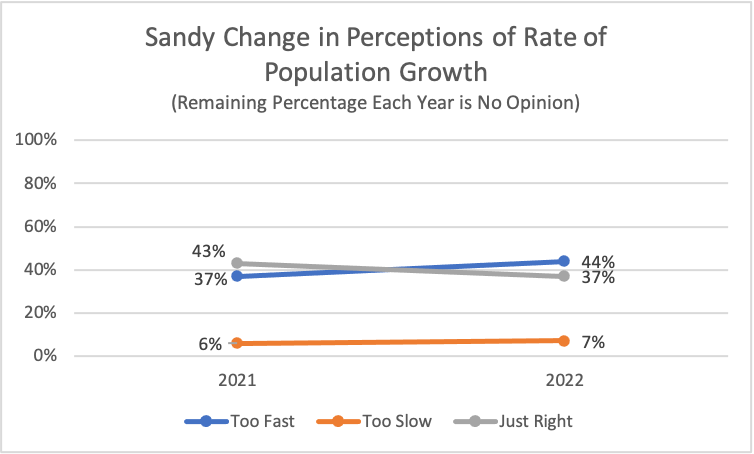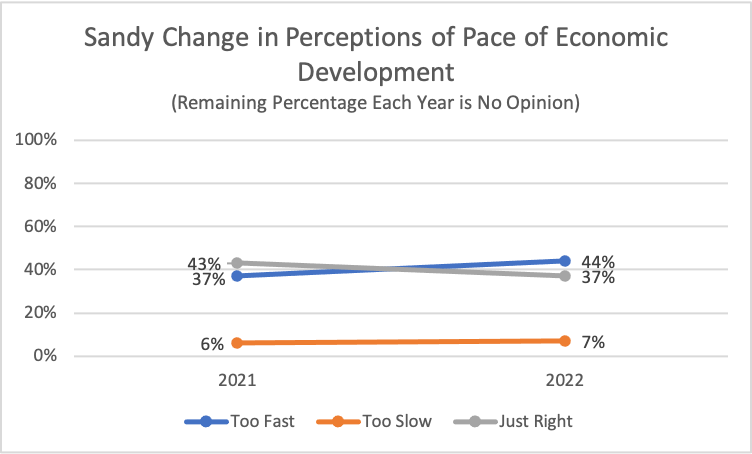Sandy Wellbeing Survey Findings 2022
By Dr. Courtney Flint and Team
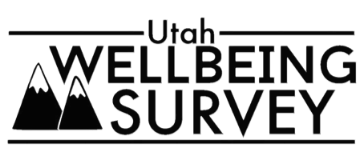
courtney.flint@usu.edu
435-797-8635
Summary
Sandy City is one of 33 cities participating in the Utah Wellbeing Survey Project in 2022. This project is designed to assess the wellbeing and local perspectives of city residents and to provide information to city leaders to inform their general planning process.
We are grateful to all participants who took the survey and to our city partners who helped to make this possible. Additionally, we are grateful to the Utah League of Cities and Towns and USU Extension for their financial support.
What is in this report?
This report describes findings from the 2022 Sandy survey and some comparative information with other project cities. Feedback from city leaders, planners, and residents is welcome.
How was the survey conducted?
Starting in February of 2022, Sandy City advertised the survey via social media, the city website, marquees, email lists, and the city newsletter. All city residents age 18+ were encouraged to take the online Qualtrics survey.
How many people responded?
- 809 viable surveys were recorded in this 2022 survey effort with 91.2% complete responses.
- The 2021 Sandy survey had 1,159 responses. Past reports are available on the Utah Wellbeing Project website.
- The adult population of Sandy was estimated at 71,590, based on the 2016-2020 American Community Survey by the U.S. Census. The 809 survey responses in 2022 represent 1.1% of the adult population and have a conservative margin of error of 3.43%.
Key Findings
Overall Personal Wellbeing and Community Wellbeing in Sandy were above average among the 33 study cities. Overall Personal Wellbeing and Community Wellbeing in Sandy declined slightly between 2021 and 2022.
Wellbeing, domain ratings, and domain importance varied greatly by demographic characteristics with age, gender, religion and income playing key roles.
Highest Rated Wellbeing Domains:
- Living Standards
- Education
- Physical Health
- Leisure Time
- Safety and Security
Most Important Wellbeing Domains:
- Mental Health
- Physical Health
- Safety and Security
- Living Standards
COVID-19 had greatest impact on Social Connections, Cultural Opportunities, and Mental Health. Overall personal wellbeing declined in last year for 31% of respondents community wellbeing declined for 34%.
The majority of respondents felt Population Growth was too fast, but attitudes were more divided about the Pace of Economic Development.
Extractive Industry was seen to have a particularly negative influence on wellbeing for the majority of respondents, though Natural Landscapes were highly positive.
Top concerns for the future of Sandy were:
- Water Supply (89% Moderate or Major Concern)
- Air Quality (86% Moderate or Major Concern)
- Public Safety (76% Moderate or Major Concern)
- Affordable Housing (75% Moderate or Major Concern)
- Roads and Transportation (71% Moderate or Major Concern)
What do people value most about Sandy?
The location, safety, good social climate, and access to nature.
Key Wellbeing Issues and Resource Areas
In addition to providing partner cities with the opportunity to take part in surveys, the Utah Wellbeing Project has worked to provide curated resources for community leaders and citizens that aim to improve specific aspects of wellbeing. These Wellbeing Resources can be found on the Utah Wellbeing Project Website, along with other useful tools and information.
Based on results of the 2022 Utah Wellbeing Project Surveys in Sandy City, key wellbeing issues include: Water Supply, Air Quality, and Public Safety. Below you will find links to specific wellbeing resource areas we believe may be used to target some of these issues.
Survey Respondent Characteristics
Table 1.1
| Full Time Residents of Sandy | 99.6% |
| Part Time Residents of Sandy | 0.4% |
| Length of Residency — Range | 0.5- 70 years |
| Length of Residency — Average | 23.9 years |
| Length of Residency — Median | 22 years |
| Length of Residence 5 years or less | 6.9% |
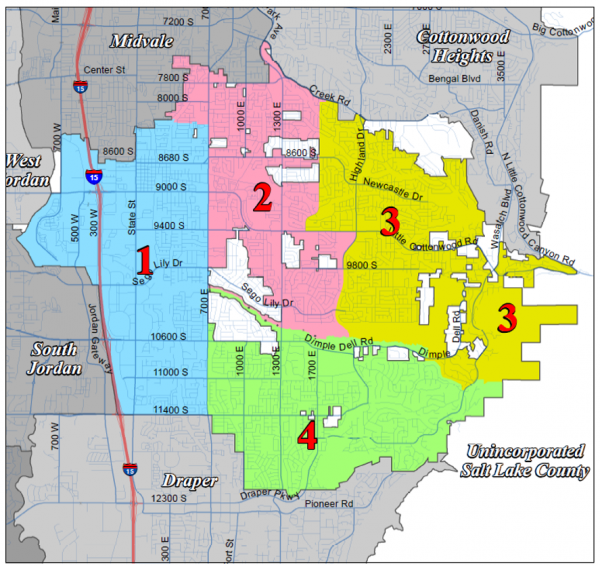
Table 1.2
| Council District 1 | 16.2% |
| Council District 2 | 24.9% |
| Council District 3 | 32.6% |
| Council District 4 | 26.3% |
Demographic characteristics of the survey respondents were compared below with U.S. Census information from the 2016-2020 American Community Survey. As the table shows, 2022 survey respondents were not fully representative of Sandy. People who have at least a 4-year college degree, age 60-69, are married, and own their home were particularly overrepresented. People age 18-29 and were particularly underrepresented. Not all respondents provided demographic information. Weighting was not used in any of the analysis for the findings presented below.
Table 2
Demographic Characteristics of Survey Respondents and U.S. Census Data for Sandy
| Demographic Characteristics | Sandy Wellbeing Survey | American Community Survey 2016-2020 Estimates |
|
|---|---|---|---|
| Online 2021 1159 Respondents |
Online 2022 809 Respondents |
||
| Age 18-29 | 2.3% | 1.4% | 21.3% |
| Age 30-39 | 13.4% | 10.5% | 18.9% |
| Age 40-49 | 21.9% | 19.0% | 16.3% |
| Age 50-59 | 21.3% | 20.4% | 16.0% |
| Age 60-69 | 24.3% | 27.3% | 15.6% |
| Age 70 or over | 16.7% | 21.5% | 11.9% |
| Adult Female | 57.6% | 58.8% | 50.6% |
| Adult Male | 41.9% | 40.5% | 49.4% |
| Adult non-conforming or non-binary |
NA | 0.7% | NA |
| No college degree | 32.1% | 32.6% | 57.0% |
| College degree (4-year) | 67.9% | 67.4% | 43.0% |
| Median household income | NA | NA | $95,715 |
| Income under $25,000 | 1.5% | 0.7% | 8.5% |
| Income $25,000 to $49,999 | 7.5% | 7.5% | 12.3% |
| Income $50,000 to $74,999 | 13.8% | 13.7% | 15.5% |
| Income $75,000 to $99,999 | 18.7% | 18.3% | 16.8% |
| Income $100,000 to $149,999 | 29.0% | 30.7% | 21.0% |
| Income $150,000 or over | 29.4% | 29.0% | 25.9% |
| Church of Jesus Christ of Latter-day Saints | 43.0% | 46.5% | NA |
| Other religion | 27.5% | 23.1% | NA |
| Agnostic/Atheist/No religious preference | 29.6% | 30.4% | NA |
| Hispanic/Latino | 2.5% | 4.0% | 10.3% |
| White | 95.0% | 94.9% | 87.4% |
| Nonwhite | 5.0% | 5.1% | 12.6% |
| Married | 82.0% | 83.7% | 57.6% |
| Children under 18 in household | 35.2% | 32.6% | 36.1% |
| Employed | 61.5% | 58.0% | 67.5% |
| Out of work and looking for work | 1.1% | 0.1% | 1.7% |
| Other | 37.4% | 41.9% | 30.8% |
| Own home/Owner occupied | 97.1% | 97.4% | 78.5% |
| Rent home/Renter occupied/Other | 2.9% | 2.6% | 21.5% |
Overall Personal Wellbeing and Overall Wellbeing in Sandy
Survey participants were asked about their overall personal wellbeing and overall community wellbeing in Sandy. These wellbeing indicators were both measured on a 5-point scale from very poor (1) to excellent (5). The average personal wellbeing score in Sandy was 4.07 with 80% of respondents indicating their wellbeing at a 4 or 5 on the 5-point scale. The average score for community wellbeing in Sandy was 3.79 with 68% of respondents indicating city wellbeing at a 4 or 5 on the 5-point scale.
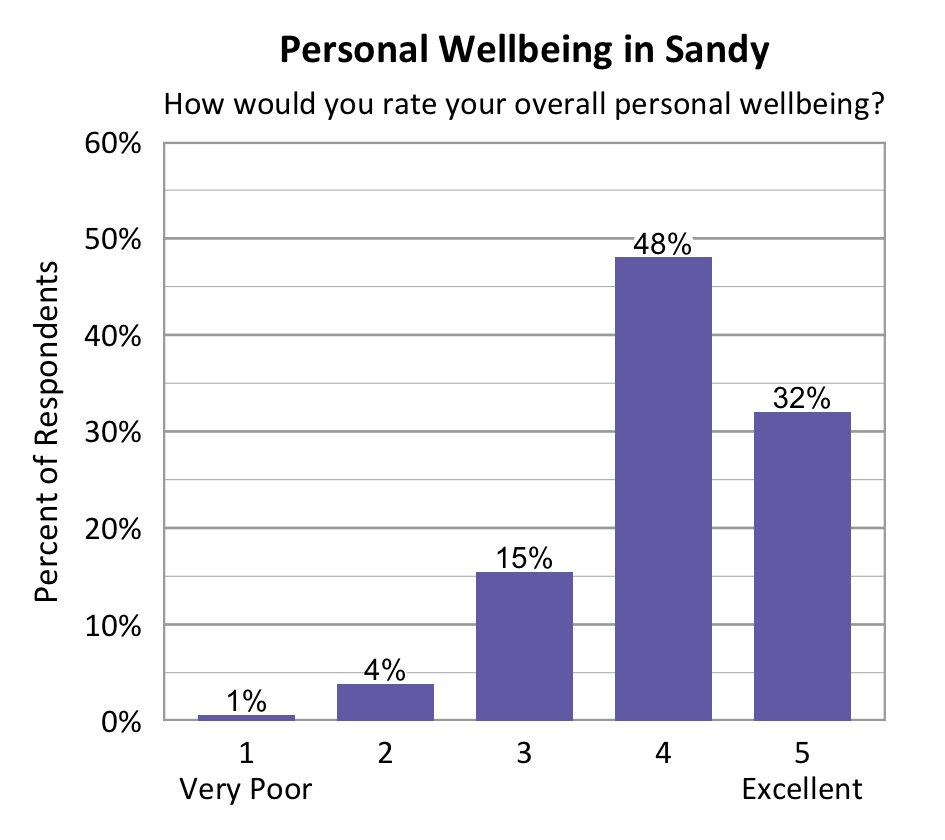

Overall personal wellbeing was higher for those in District 3, but these differences were not statistically significant. Community wellbeing was also higher for those in District 3, however, this difference was only statistically significant when compared to District 1.
Comparing survey data from Sandy over the years as shown in the information below, we can see that the average personal wellbeing score declined between 2021 and 2022 and the community wellbeing score remained nearly the same. Note that the number of respondents differed between years and there is no tracking of individuals from one year to the next.
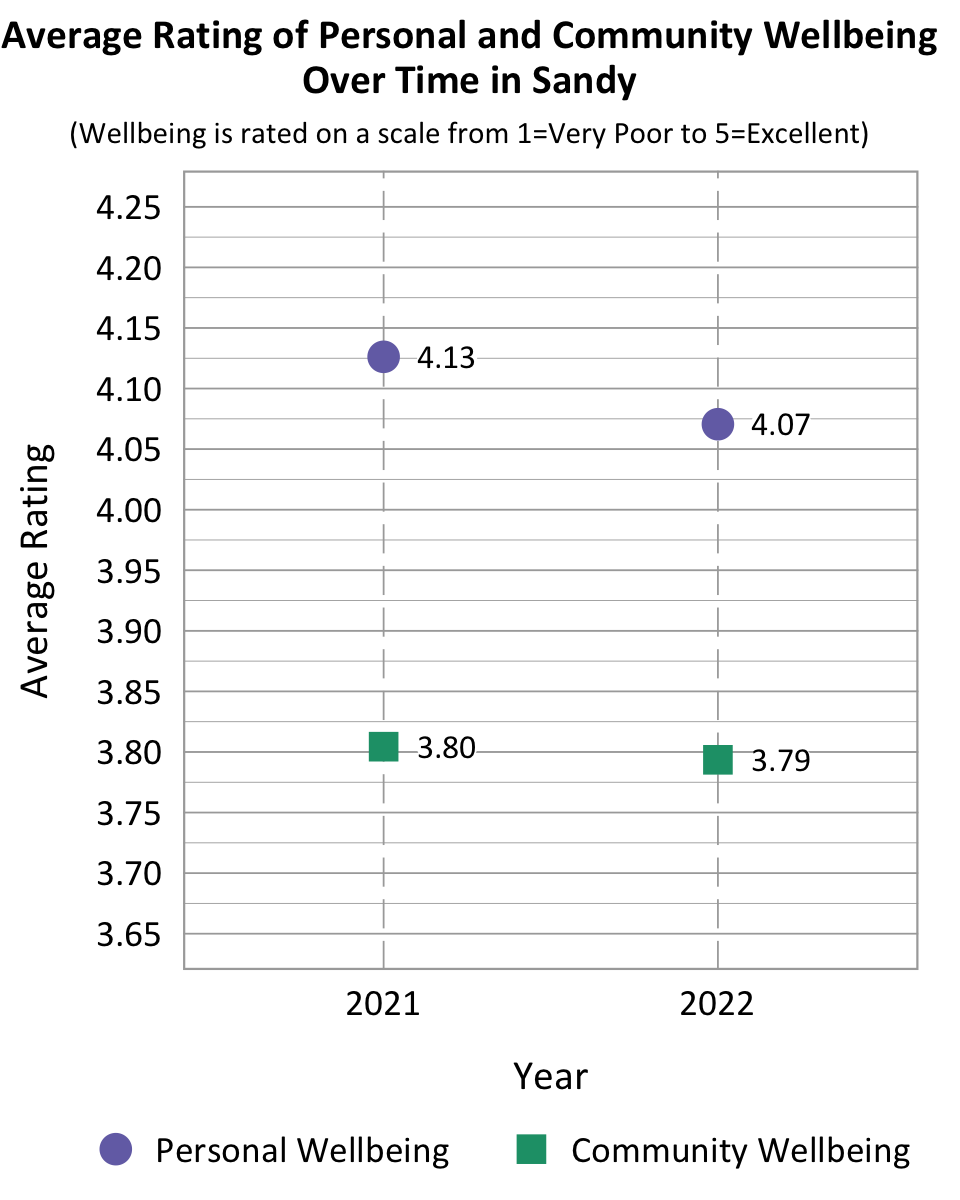
Perceived Changes to Wellbeing in the Last Year
The COVID-19 Pandemic has dominated the last couple of years. Survey respondents were asked if their overall personal wellbeing or community wellbeing changed in the last year. Survey findings show that 31% of respondents indicated that their personal wellbeing declined in that time and 26% of respondents indicated that their personal wellbeing had improved in that time. For community wellbeing, 34% of respondents indicated it had declined in the last year and 14% indicated it had improved.
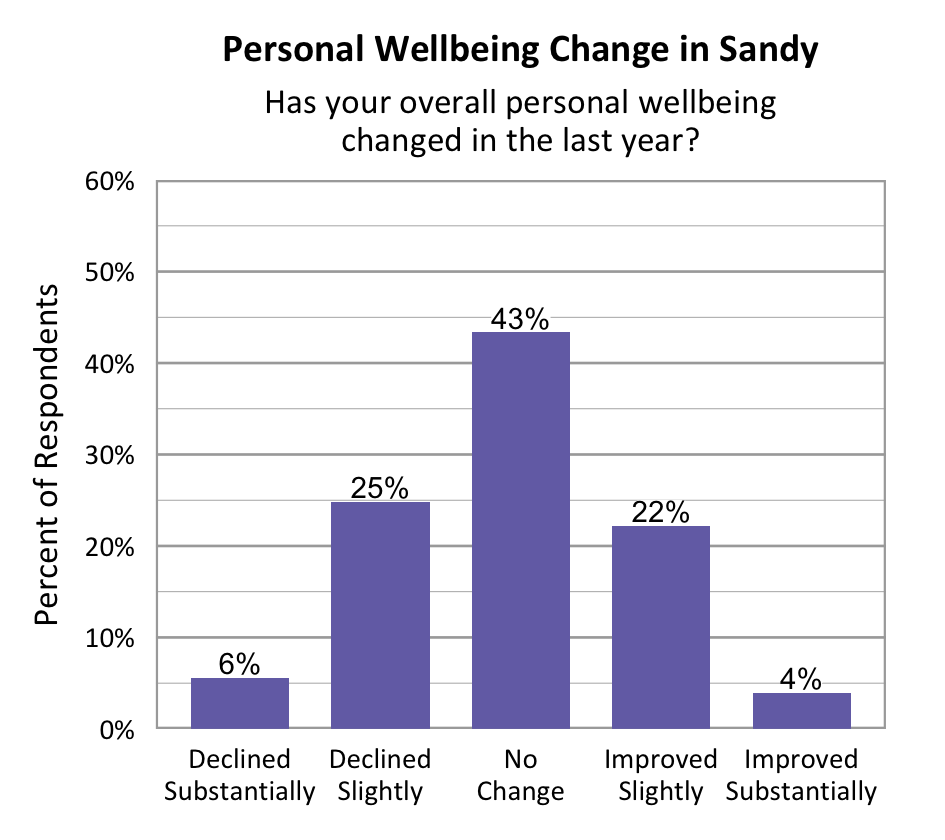
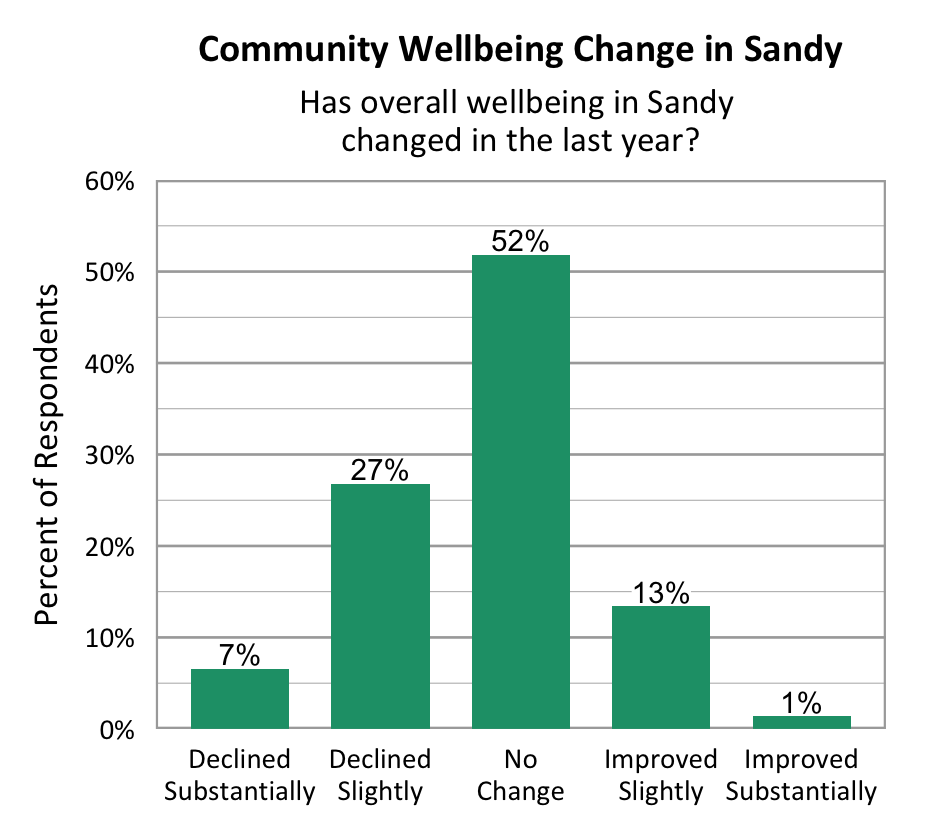
Comparing Wellbeing Across Utah Cities
The Utah League of Cities and Towns classifies Sandy as a City of the 1st & 2nd Class (and we have combined these with Mid-Sized Cities). Some cities may fit within more than one cluster.
Within the more urban city cluster, Sandy fell just above the cluster average in terms of the overall personal wellbeing and community wellbeing scores. Sandy was only statistically significantly higher than Tooele in terms of overall personal wellbeing and not significantly different from any other city in the cluster. In terms of community wellbeing, Sandy was significantly higher than Tooele, Midvale, Logan, and West Jordan. Margins of error are particularly high for Delta, Helper, Midvale, and Santaquin due to low survey response.
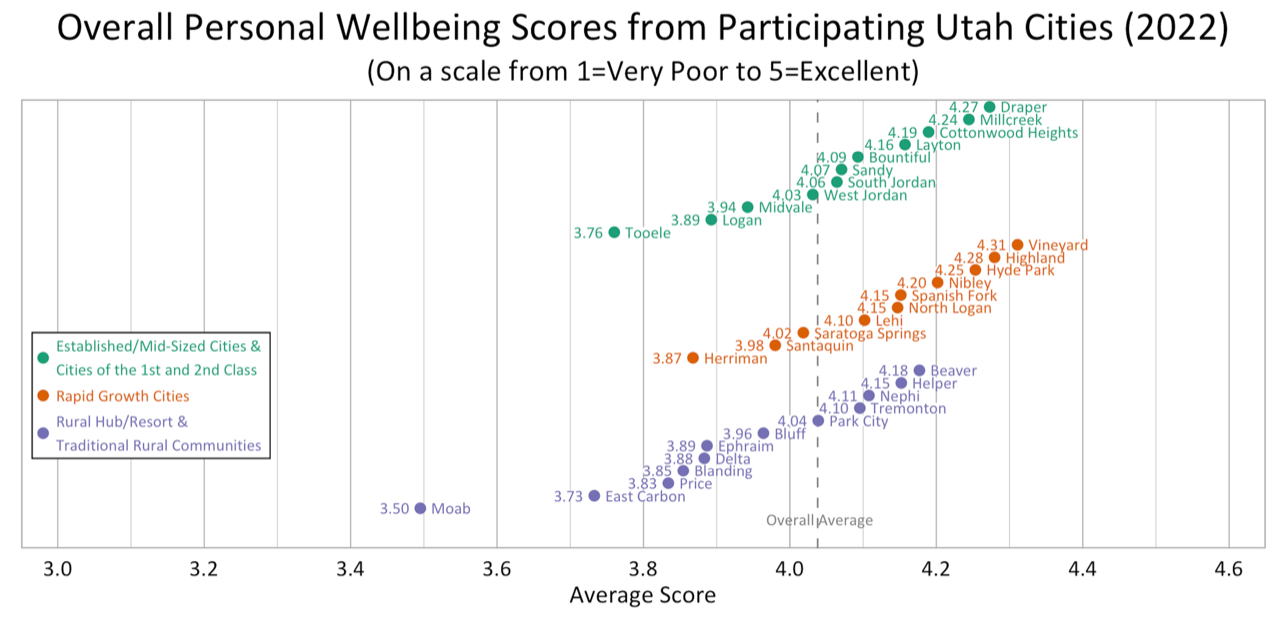
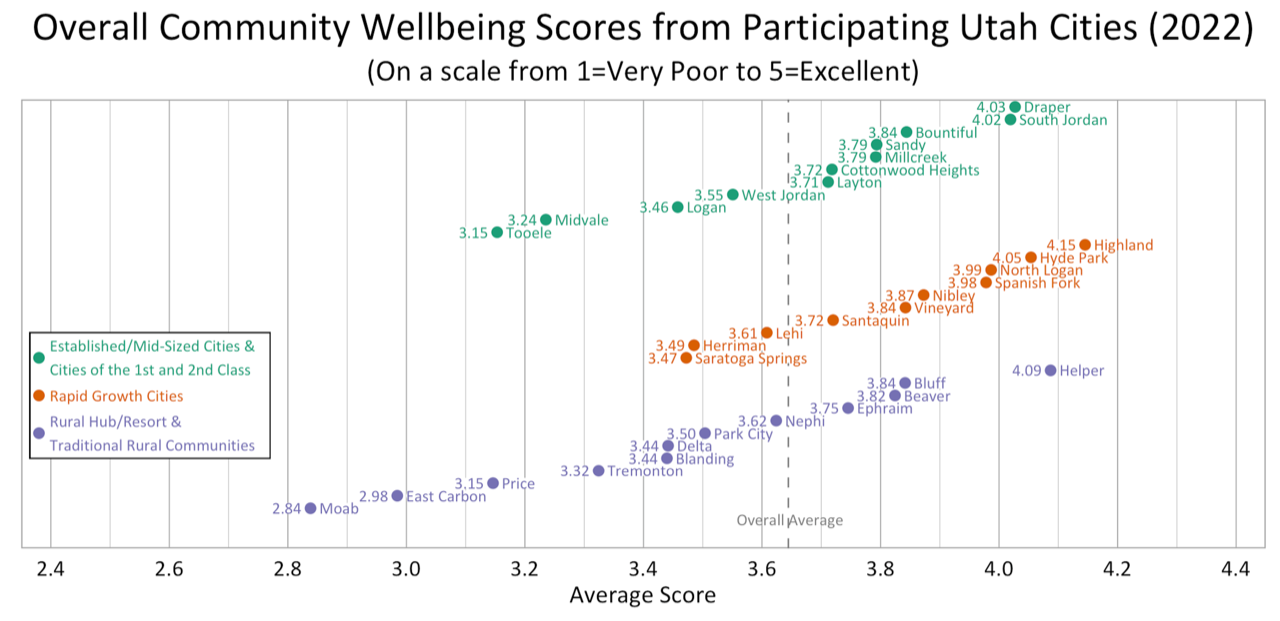
Wellbeing Domains in Sandy
According to national and international entities that track wellbeing, there are a number of common dimensions or domains of wellbeing. In this survey, respondents rated ten domains on a 5-point scale from poor to excellent, suggesting how their wellbeing was doing in each area. They were also asked to indicate the importance of each domain to their overall personal wellbeing on a 5-point scale from not at all important to very important. The highest rated wellbeing domain for respondents in Sandy was Living Standards (83%). The four most important wellbeing domains were Mental Health (98%), Physical Health (96%), Safety and Security (95%), and Living Standards (92%).

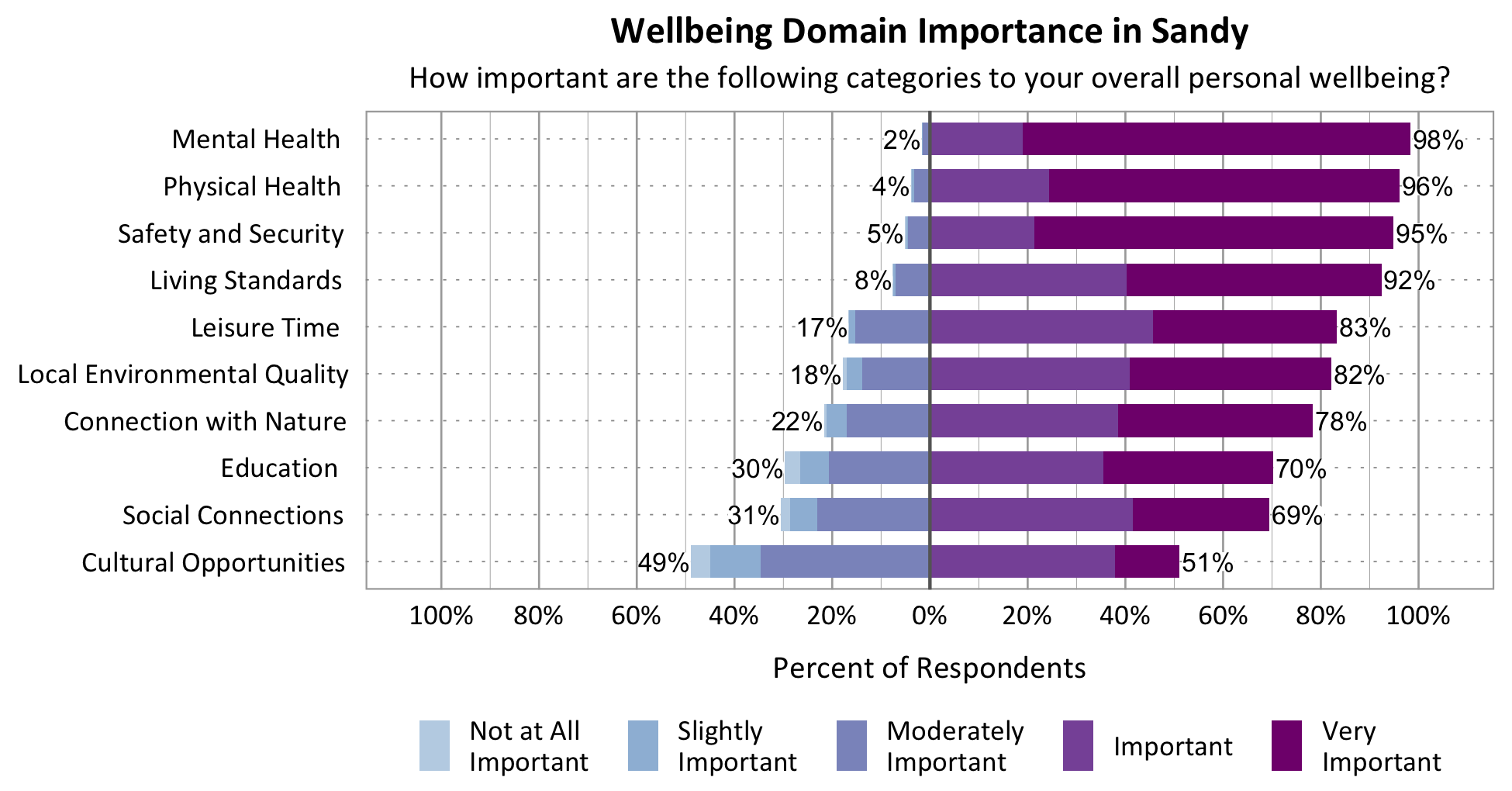
Wellbeing Matrix for Sandy
The graph below illustrates the relationship between the average rating and the average importance of wellbeing domains for survey respondents from Sandy. Mental Health, Physical Health, and Living Standards were highly important and rated above average among the domains. No domains fell in the “red zone” of higher importance, but lower ratings. However, Local Environmental Quality and Physical Health approached this zone.
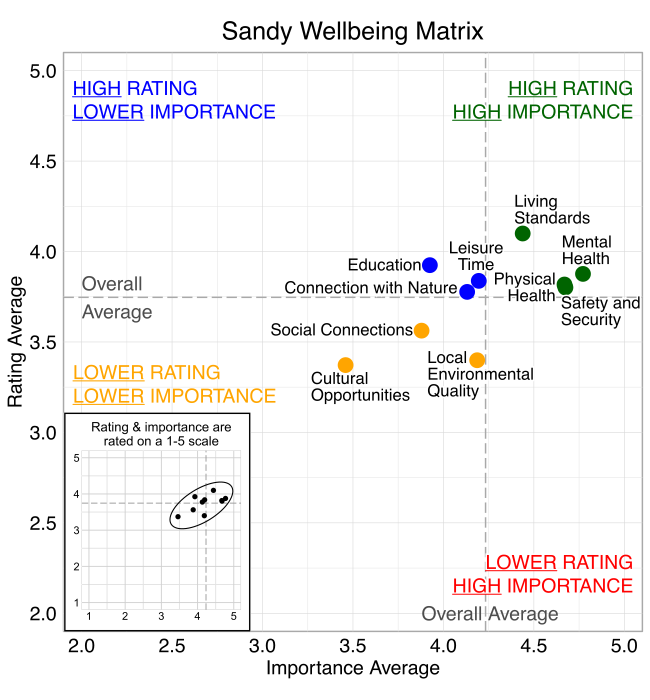
Wellbeing Domains Over Time in Sandy
The graphs below show how the domains were rated over the years by Sandy residents (irrespective of the COVID-10 Pandemic). The number of respondents changed over time. There was considerable increase in ratings for education, social connections, and cultural opportunities in the last year.
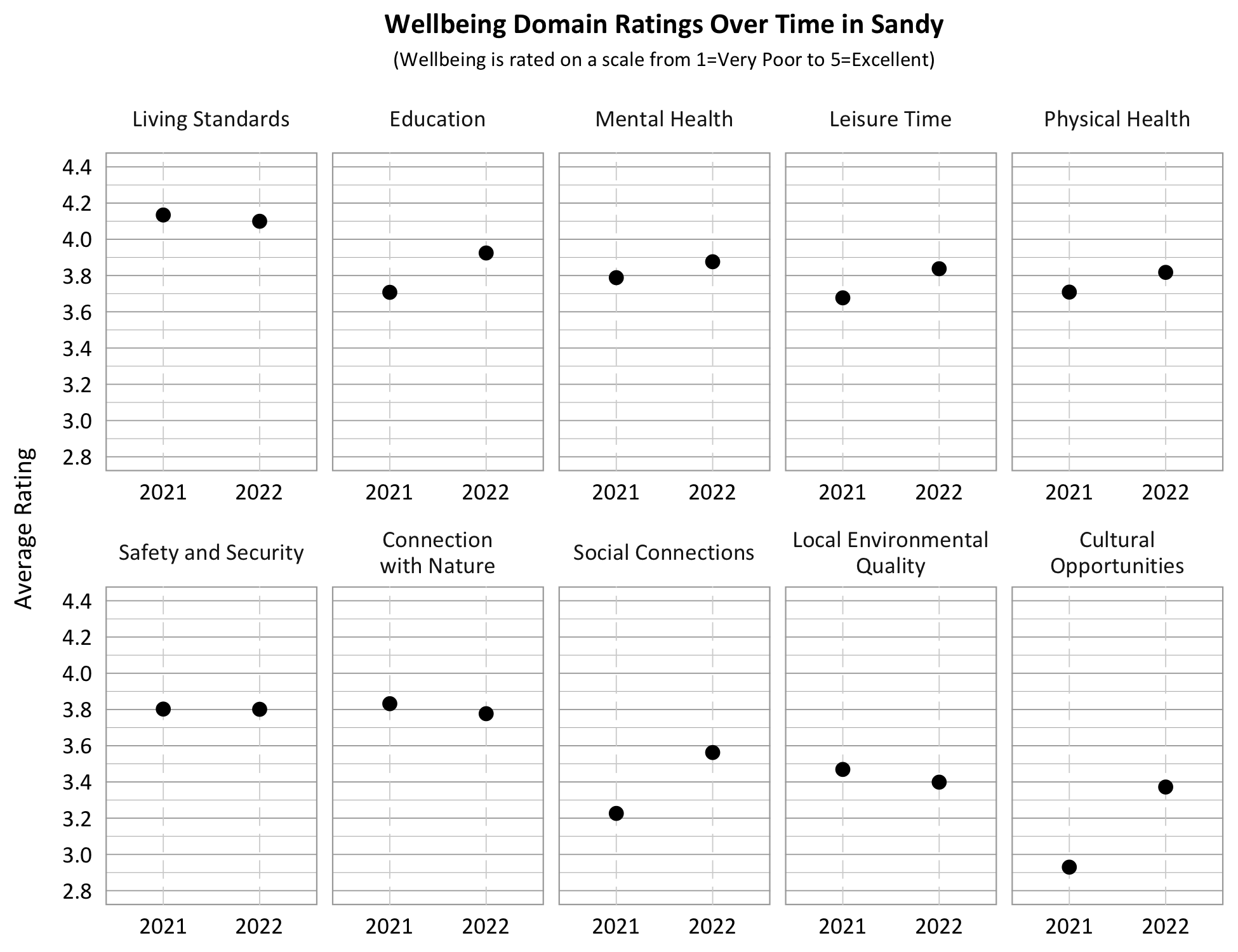
How did the COVID-19 Pandemic Impact Wellbeing Domains?
The COVID-19 Pandemic’s impact was most strongly felt regarding Social Connections and Cultural Opportunities. Improvements were reported in Connection with Nature for 21% of respondents.
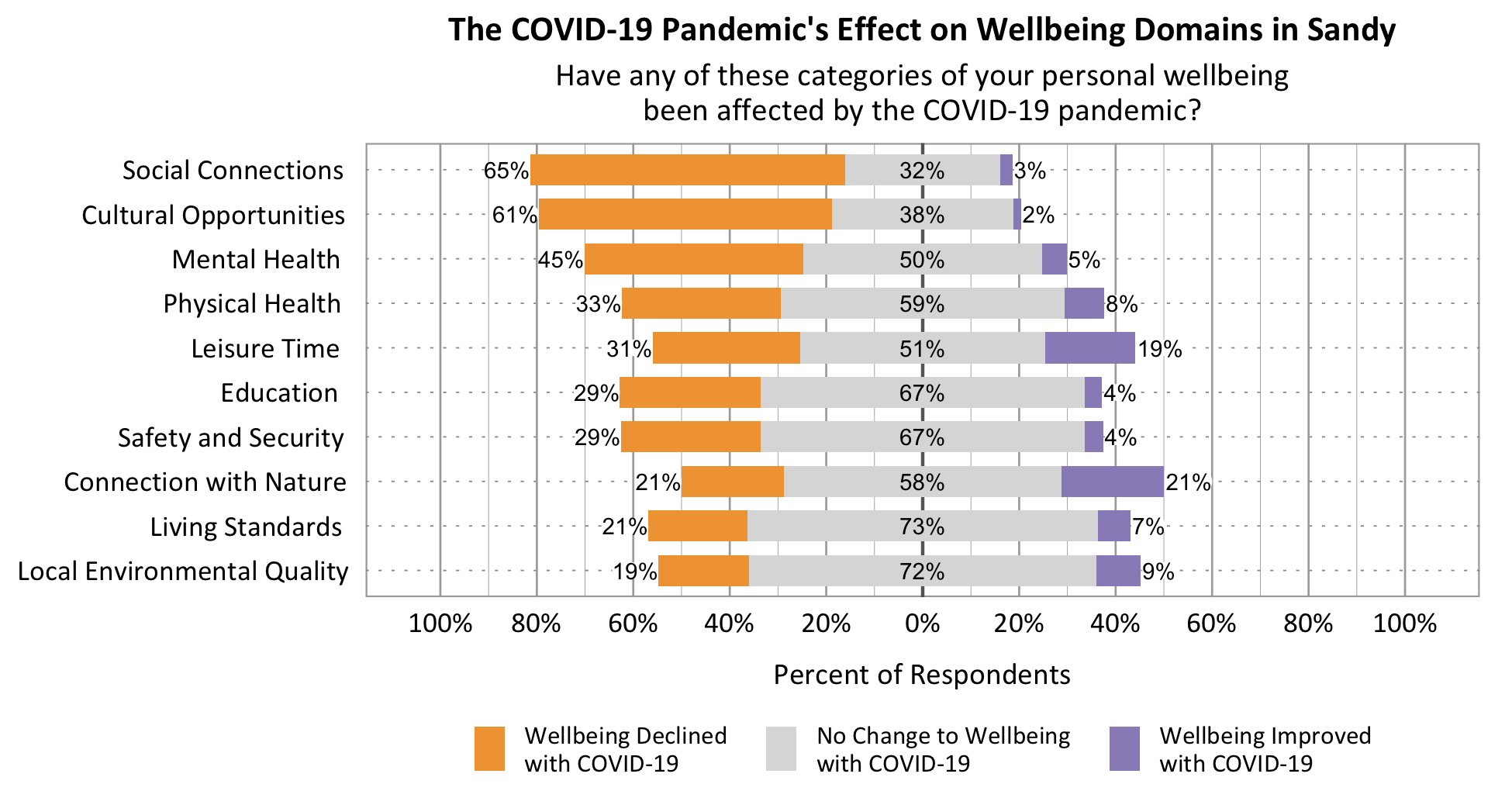
How are Demographic Characteristics Related to Wellbeing?
The demographic variables for age, gender, college degree, religion, income, and length of residence were were found to have varying relationships among Sandy respondents as shown in the table below based on a generalized linear model with unweighted data. The +/- sign indicates whether the wellbeing score in the specific demographic group was significantly higher or lower than the reference group in each demographic variable (p<.05).
Table 3
Relationship Between Demographic Characteristics and Wellbeing Domains in Sandy
| Domains Rated | Demographic Variables | |||||
|---|---|---|---|---|---|---|
| Age 60+ | Female | College Degree | Latter-day Saint | Highest Income ($150,000+) |
Resident 5 Years or Less | |
| Wellbeing Ratings | ||||||
| Overall Personal Wellbeing | + vs 40-59 |
+ |
+ |
+ |
||
| Wellbeing in Sandy | + vs 40-59 |
|||||
| Connection with Nature | + |
+ vs Under $75,000 |
||||
| Cultural Opportunities | + |
+ |
||||
| Education | + |
+ |
+ | |||
| Leisure Time | + |
+ vs Under $75,000 |
||||
| Living Standards | + |
+ | + |
|||
| Local Environmental Quality | + |
+ vs A/A/NRP |
+ vs Under $75,000 |
|||
| Mental Health | + |
- | + |
+ vs Under $75,000 |
||
| Physical Health | + vs 40-59 |
+ |
||||
| Safety & Security | + |
+ | + vs Under $75,000 |
|||
| Social Connections | + | + | + vs Under $75,000 |
|||
| Age 60+ | Female | College Degree | Latter-day Saint | Highest Income ($150,000+) |
Resident 5 Years or Less | |
| Domains | Domain Importance | |||||
| Connection with Nature | + |
- | + vs Under $75,000 |
|||
| Cultural Opportunities | + | + | + vs Under $75,000 |
|||
| Education | + vs 18-39 |
+ |
+ | + vs Under $75,000 |
||
| Leisure Time | - | + vs Under $75,000 and $100,000-$149,999 |
||||
| Living Standards | + |
+ vs Under $75,000 |
||||
| Local Environmental Quality | + | - | ||||
| Mental Health | + |
- vs A/A/NRP |
+ vs Under $75,000 and $100,000-$149,999 |
|||
| Physical Health | + |
+ vs Under $75,000 and $100,000-$149,999 |
||||
| Safety and Security | + | + vs A/A/NRP |
+ vs $100,000- $149,999 |
|||
| Social Connections | + vs 40-59 |
+ | ||||
Community Action and Connection in Sandy
Survey participants were asked about community actions and community connection in Sandy. Both questions were scored on a 5-point scale from not at all (1) to a great deal (5). When asked about the degree to which people take action together in response to local problems or opportunities in Sandy, the average score was 3.03. When asked about the degree they feel connected to their community, the average score was 2.99.
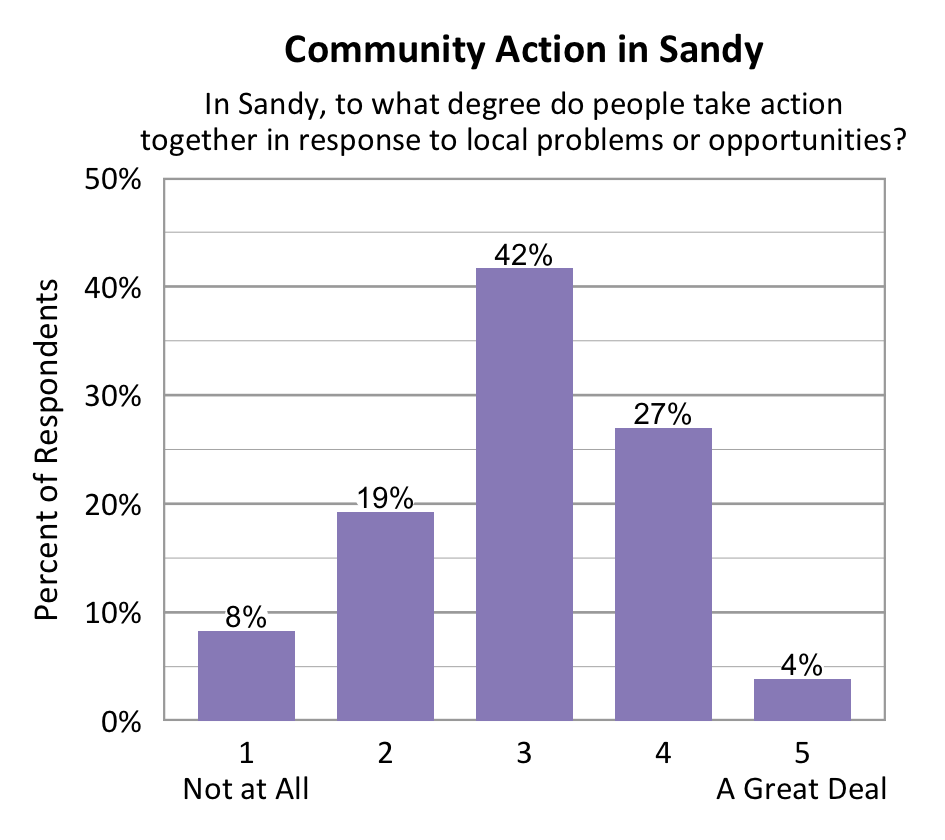
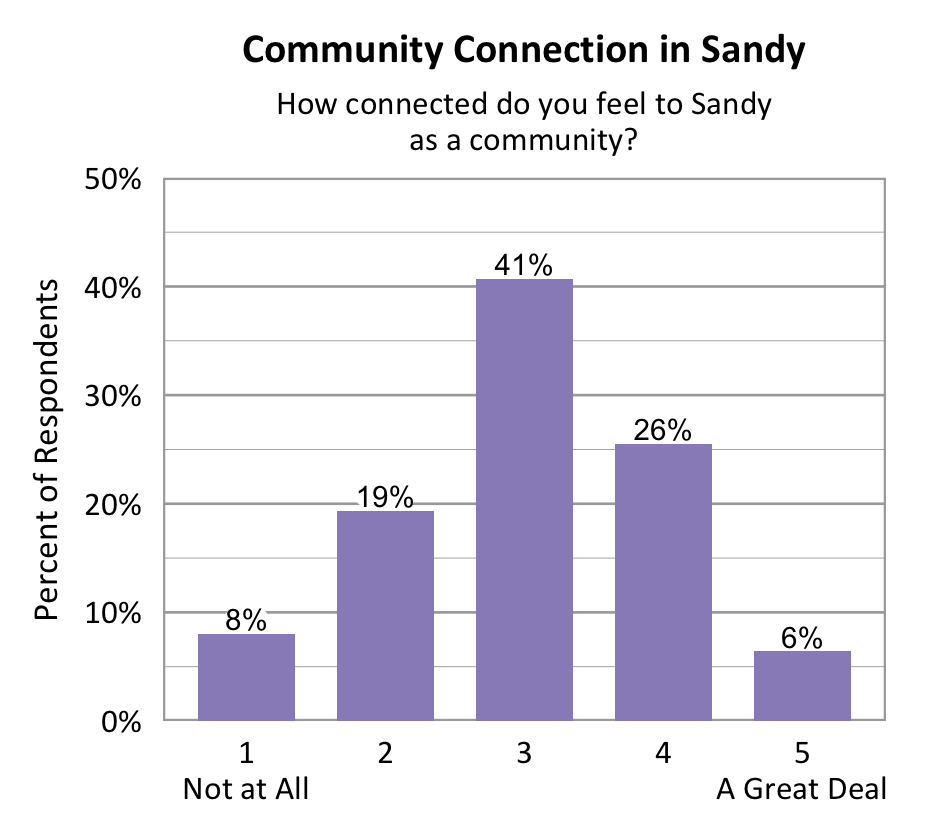
Latter-day Saints reported higher levels of community connection and higher perceptions of local action than those from other religions or those who indicated Agnostic/Atheist/No Religious Preference. Respondents age 60+ reported higher perceptions of local action than all other age groups, and higher levels of community connection than those age 40-59. Respondents with a college degree reported lower perceptions of local action than those without a college degree. Respondents in the highest income category ($150,000+) reported higher levels of community connection and higher perceptions of local action than those with household incomes under $75,000. This was based on a generalized linear model with unweighted data (p < 0.05).
Table 4
Demographic Characteristics and Community Questions
| Community Questions | Age 60+ | Female | College Degree | Latter-day Saint | Highest Income ($150,000+) |
Resident 5 Years or Less |
|---|---|---|---|---|---|---|
| Do people in Sandy take action? | + |
- | + |
+ vs Under $75,000 |
||
| Do you feel connected to your community? | + vs 40-59 |
+ |
+ vs Under $75,000 |
A significant, positive relationship was found between individuals’ community connection and overall personal wellbeing.
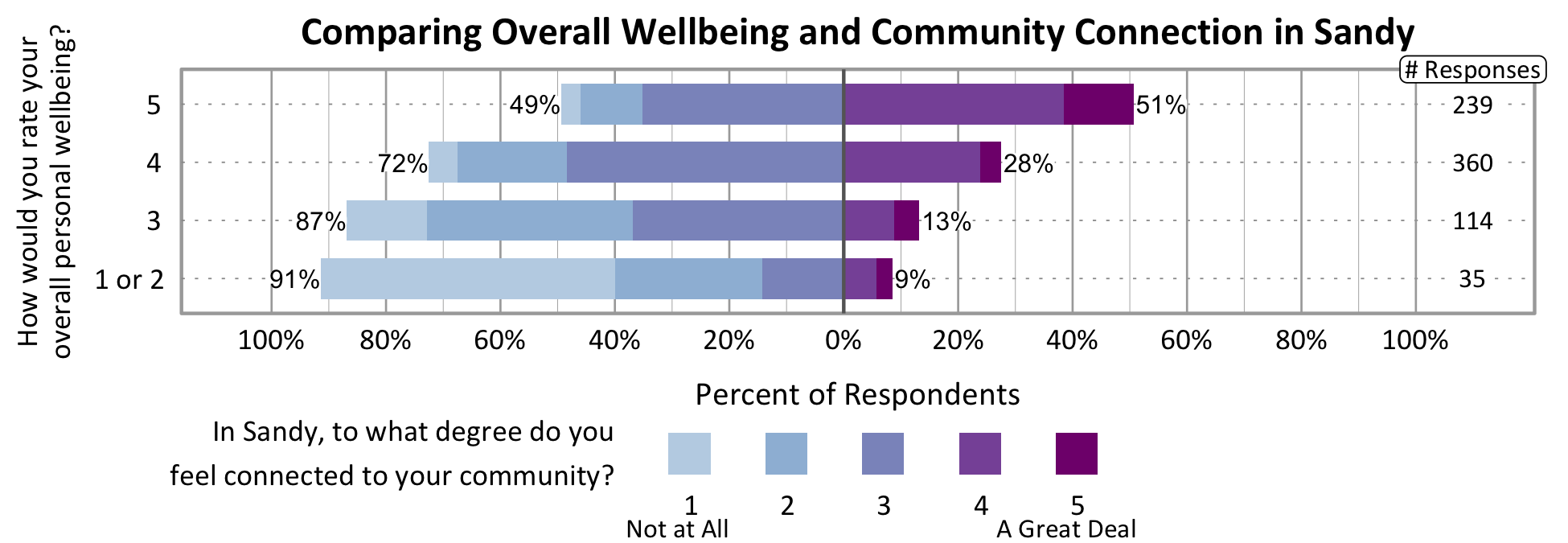
Comparing Community Action and Connection Across Cities
The graphs below show how Wellbeing Project cities compare on the degree to which people take action in response to local problems and opportunities and how connected people feel to their city as a community. Sandy was in the lower half on perceived community action and community connection based on the number of people indicating a 4 or 5 on a 5-point scale. Margins of error are particularly high for Delta, Helper, Midvale, and Santaquin due to low survey response.
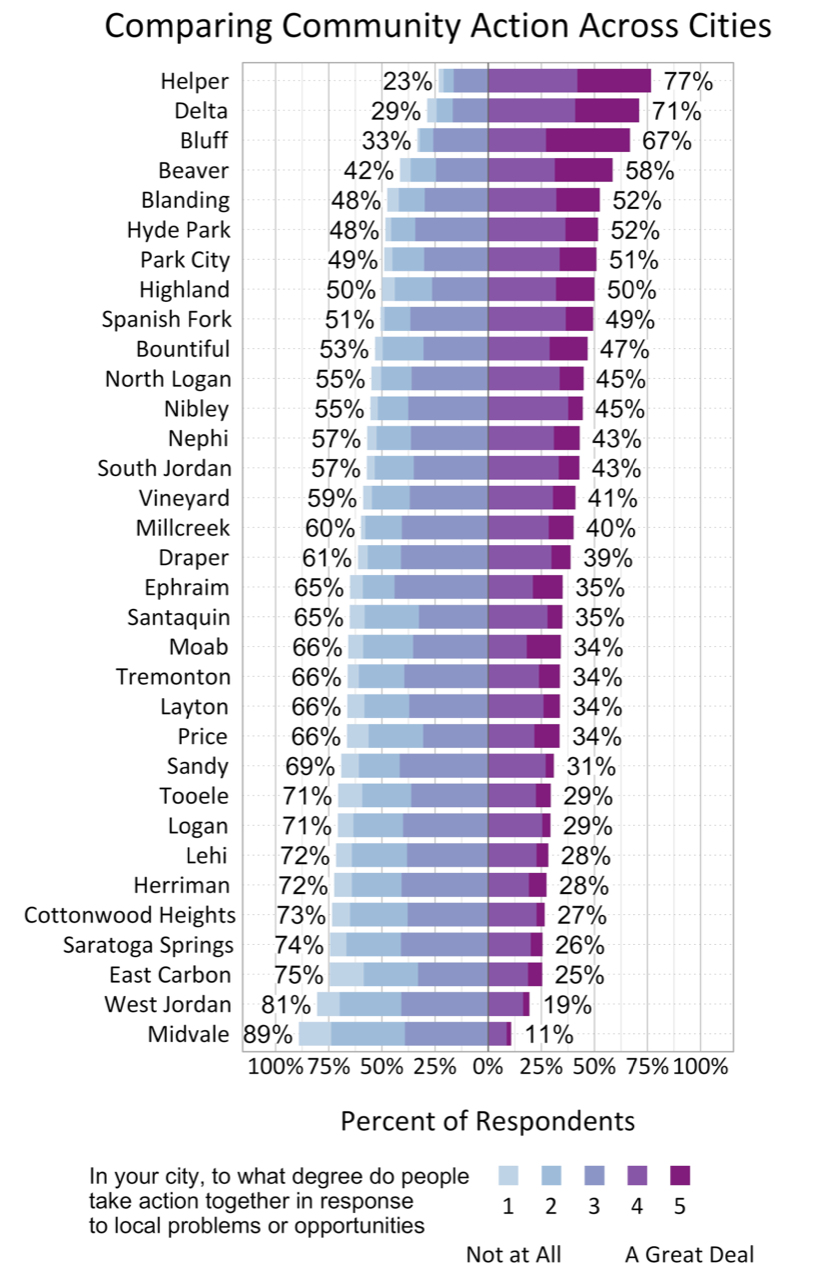
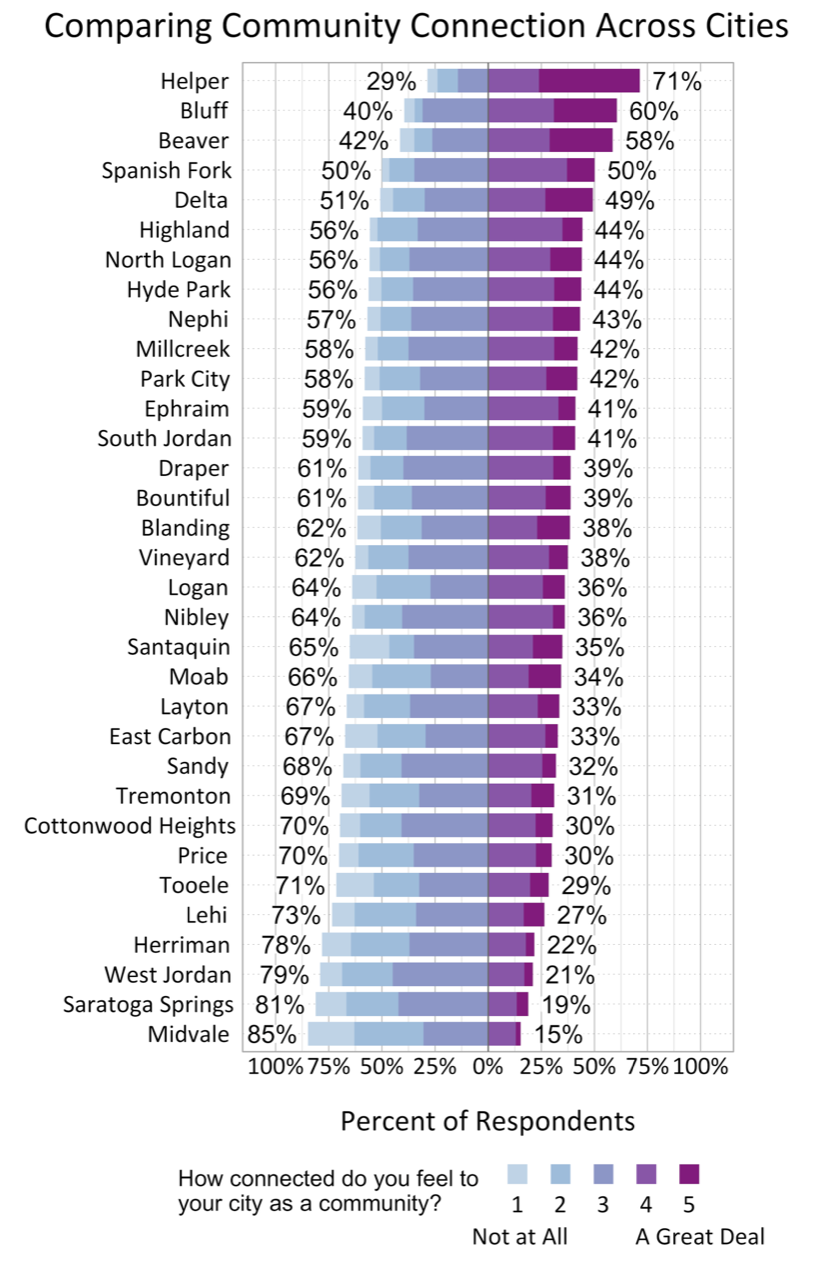
Participation in Recreation and Nature-Related Activities
Respondents were asked to indicate whether or not they participated in eight different recreation or nature-based activities in the past 12 months. Enjoying wildlife and birds in your yard or neighborhood (84%) was the most common activity for respondents, followed by gardening (83%) and recreating in parks in the city (76%).
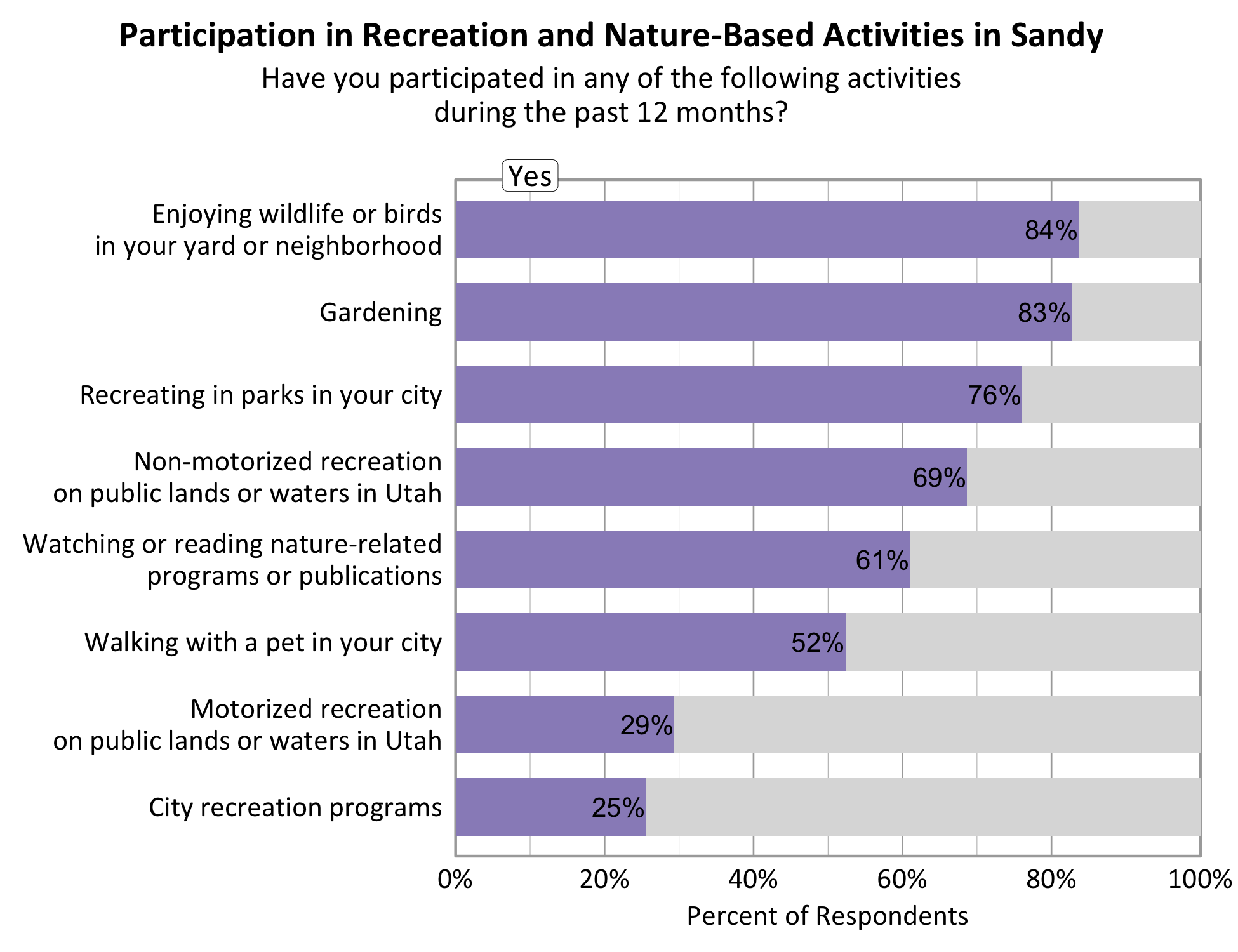
For Sandy respondents, participating in non-motorized recreation on Utah public lands or waters and recreating in city parks were positively and significantly related to overall personal wellbeing.
Participating in city recreation programs and recreating in city parks were positively and significantly related to community wellbeing.
Participating in motorized or non-motorized recreation on Utah public lands or waters, participating in city recreation programs, recreating in city parks, and gardening were positively and significantly related to community connection.
Influence of Landscape on Wellbeing
Survey participants were asked about the influence of landscape features on their wellbeing. Natural landscapes including mountains, city parks, rivers and streams, and trails were found to have an overwhelmingly positive influence on wellbeing. In terms of development and industry in the landscape, respondents were more divided. There was a particularly strong negative perception of extractive industry among Sandy respondents.
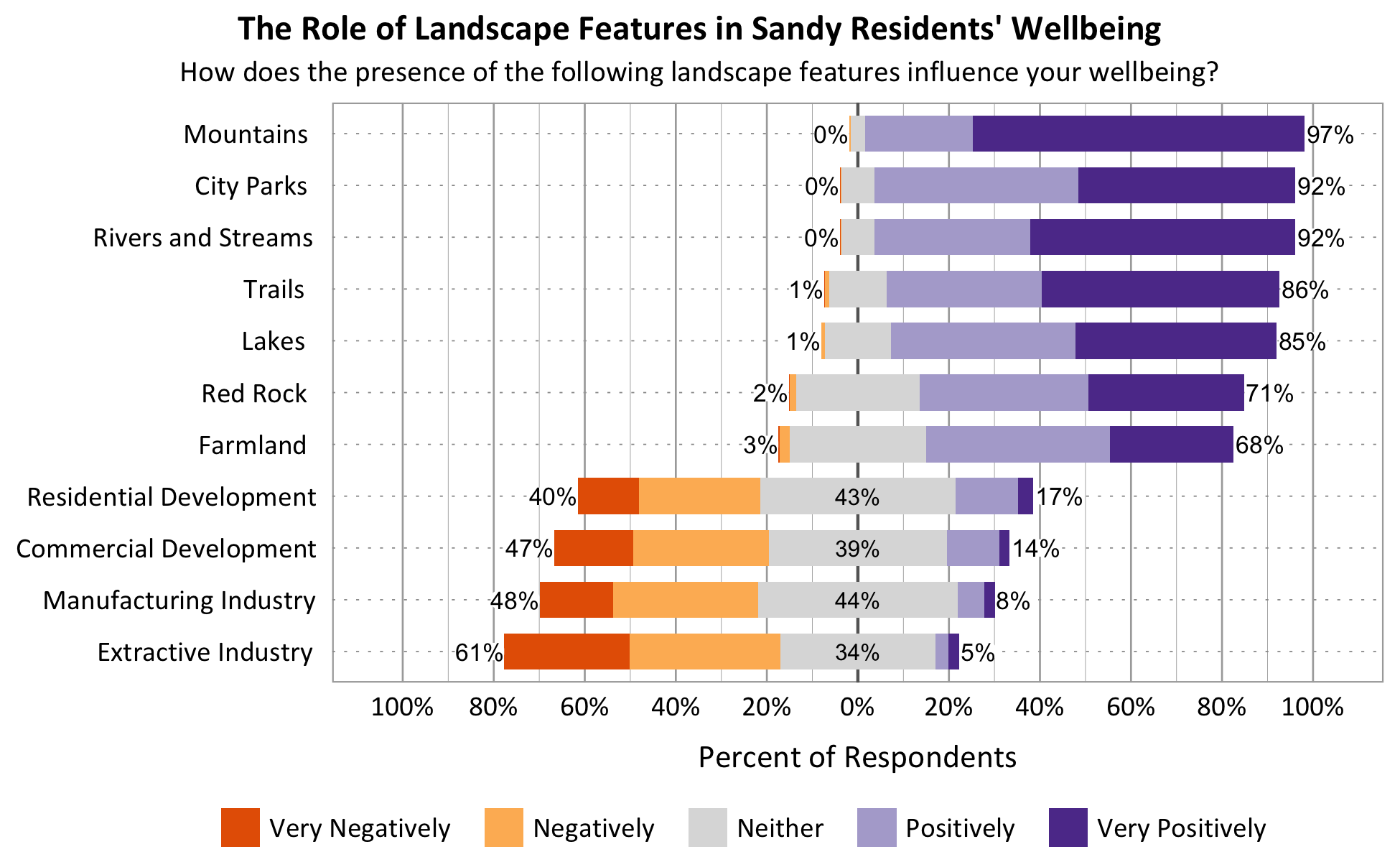
Perspectives on Population Growth and Economic Development
The majority of Sandy survey respondents indicated they felt population growth was too fast (66%). On the pace of economic development respondents were more evenly distributed, with 44% indicating it was too fast, and 37% indicating it was just right.
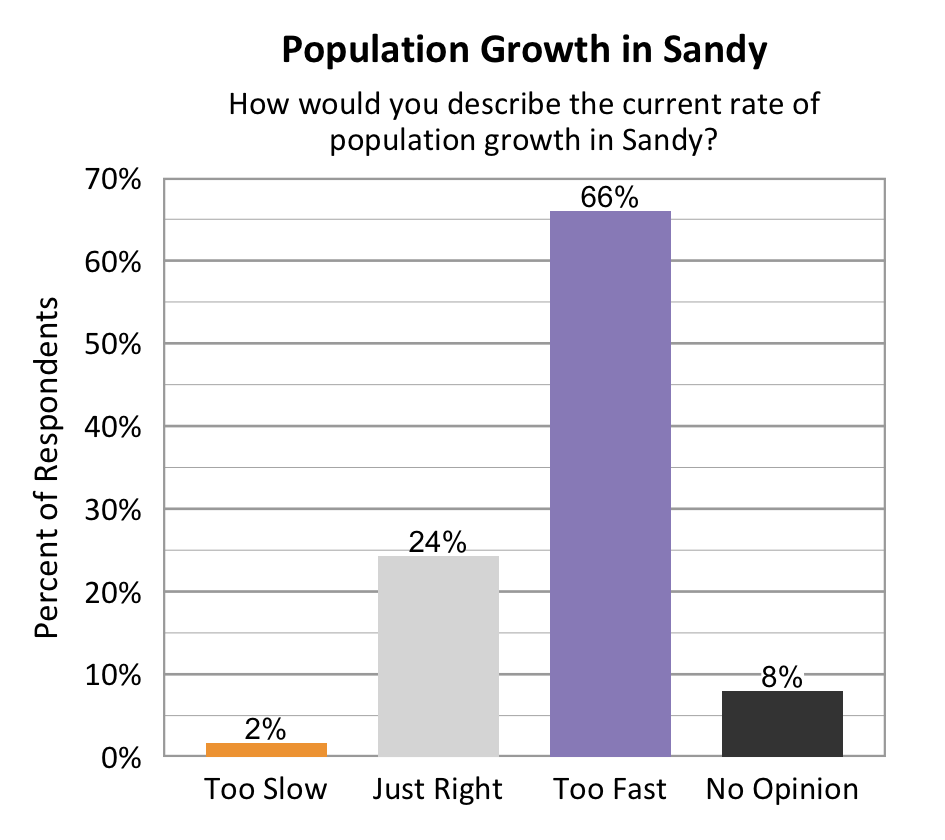
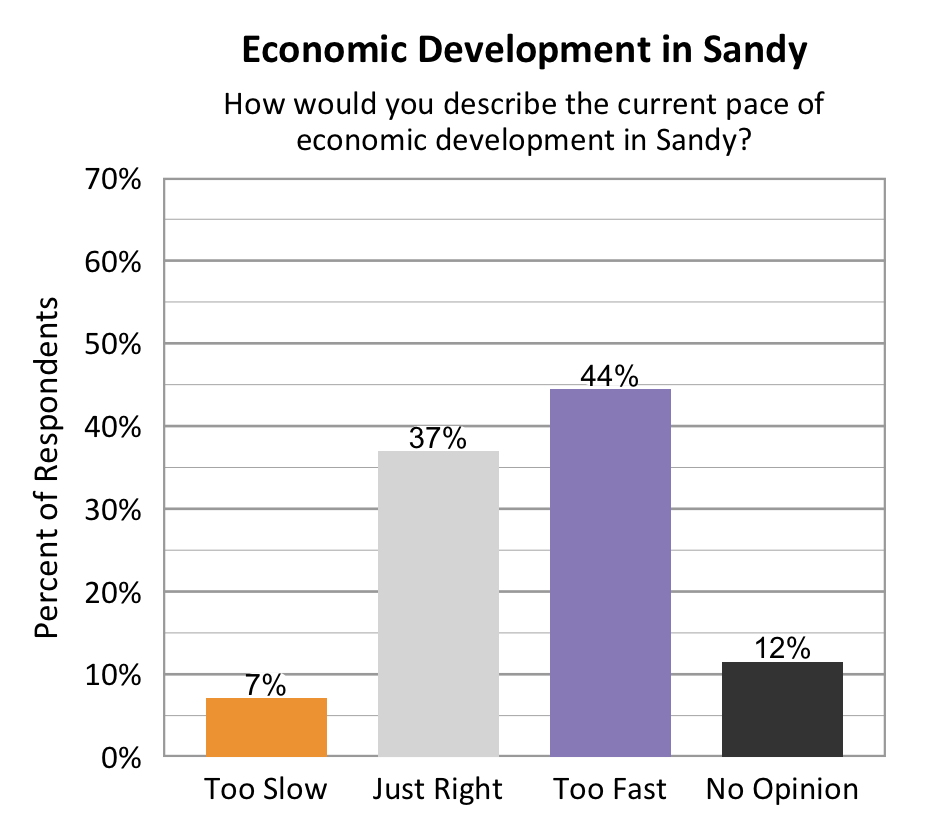
The graphs below show how perceptions of population growth and economic development in Sandy have changed between 2021 and 2022. On both the rate of population growth and the pace of economic development, the ratio of those indicating it's too fast to those indicating it's just right nearly flipped between 2021 and 2022, but the change is minimal.
The graphs below show how Sandy compares to other participating cities in the Wellbeing Project on these perceptions of population growth and economic development in 2022. Margins of error are particularly high for Delta, Helper, Midvale, and Santaquin due to low survey response.
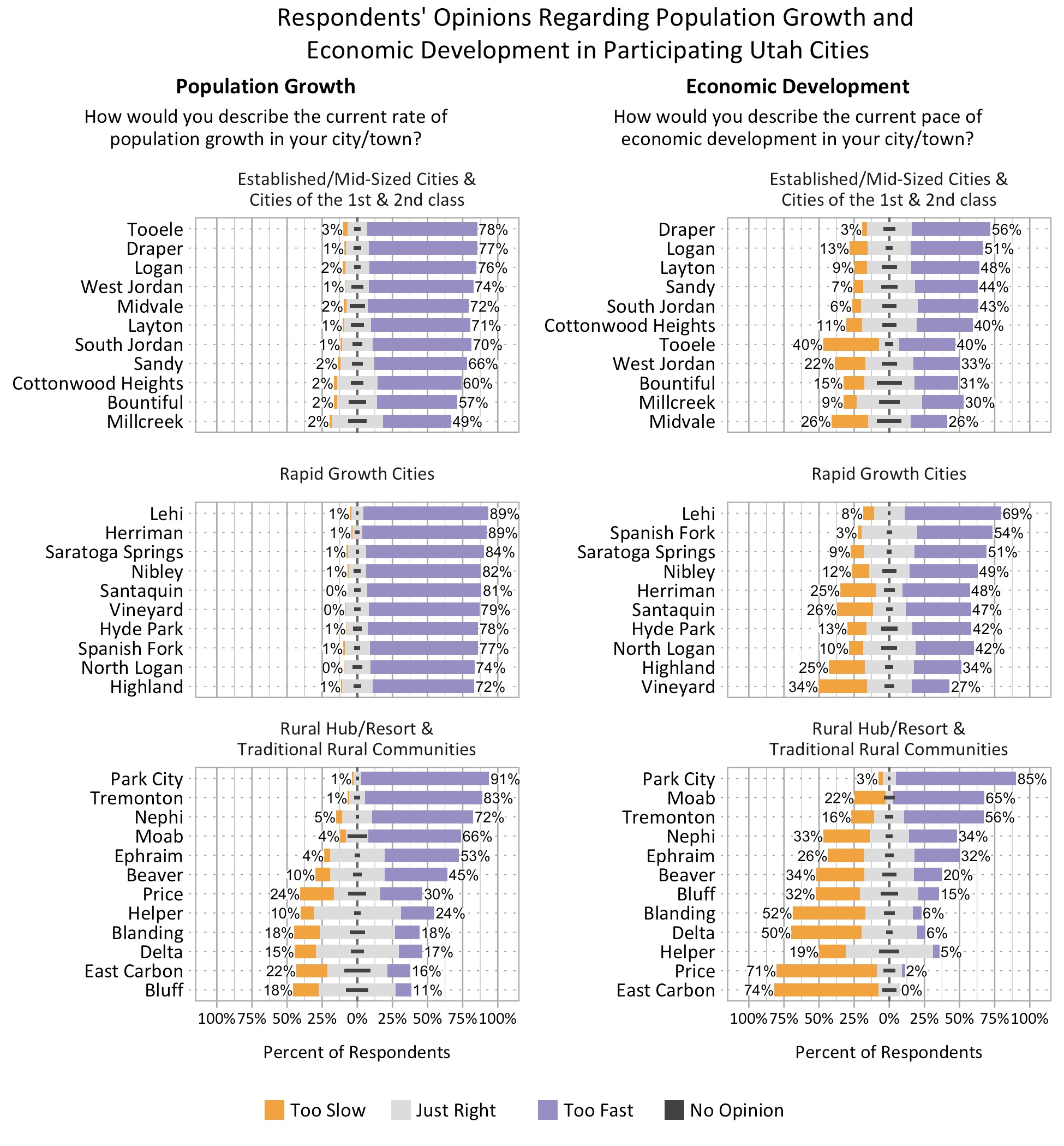
Concerns in Sandy
Survey respondents indicated the degree to which a number of possible local issues were a concern as they look to the future of Sandy. Water Supply, Air Quality, Public Safety, and Affordable Housing were the top four concerns with at least 75% of respondents indicating these were moderate or major concerns.
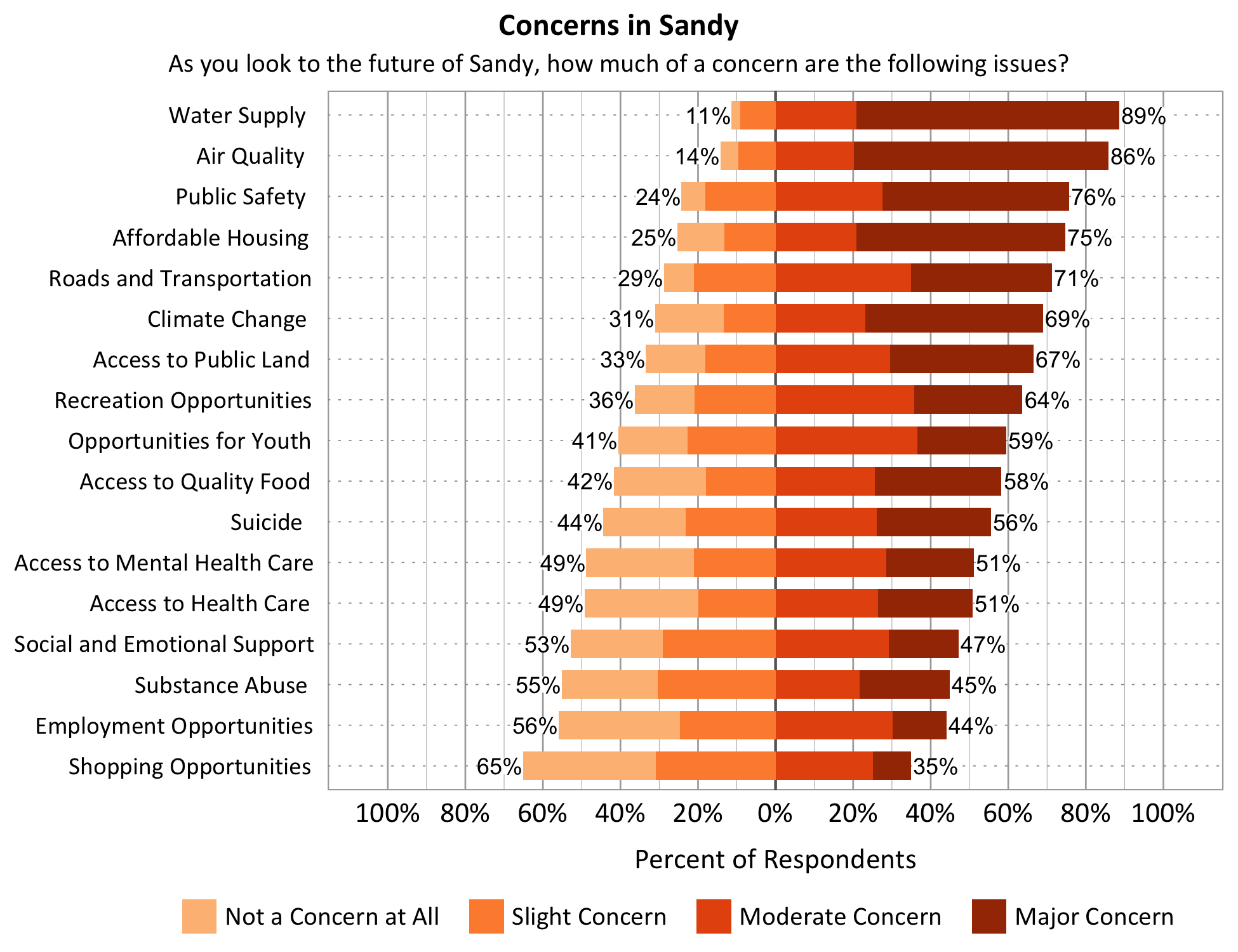
Other concerns were raised by 184 respondents who filled in the “other” category. Responses identical to the categories above are not included in the table.
Table 5
Other Concerns Mentioned |
||
|---|---|---|
| High density housing, overdevelopment (24) |
Infrastructure, utilities (4) |
Illegal immigration |
| Overpopulation, overcrowding (14) | Businesses (4) | Wildlife management |
| Gondola (12) | Education (3) | Respectful discourse |
| Government (11) | City image (3) | Senior care |
| Traffic (10) | Recycling (3) | Street lighting |
| Inflation, cost of living (6) | Noise (3) | Cultural opportunities |
| Taxes (5) | Fluoride in water (3) | Emergency preparedness |
| Politics (5) | Canyon preservation (3) | Equality |
| Diversity (4) | Environmental quality (3) | Public opinion about living in Sandy |
| Walkability and bikeability (4) | Light pollution (2) | Community |
| Home rentals (4) | Trauma informed care (2) | Homeless population |
| Public transportation (4) | Pets (2) | Fire |
| Restaurants (4) | Corruption | |
Open Comments
Survey respondents were asked to comment on what they value most about Sandy and to provide any additional comments about wellbeing in Sandy. Comments have been shared with city leaders. In summary, residents of Sandy highly valued the location. The social climate was also valued, comments include good neighbors and community. Safety as well as the nature and beauty found in Sandy were also of value. The additional comments section included comments about housing as well as growth and development, many worried about the rapid pace of both. Comments were also made about the government in Sandy, some worried about the current leadership and some excited for the new mayor. There were also comments about the social climate in Sandy, comments ranged from enjoying the current social climate while others wished it was more welcoming.


